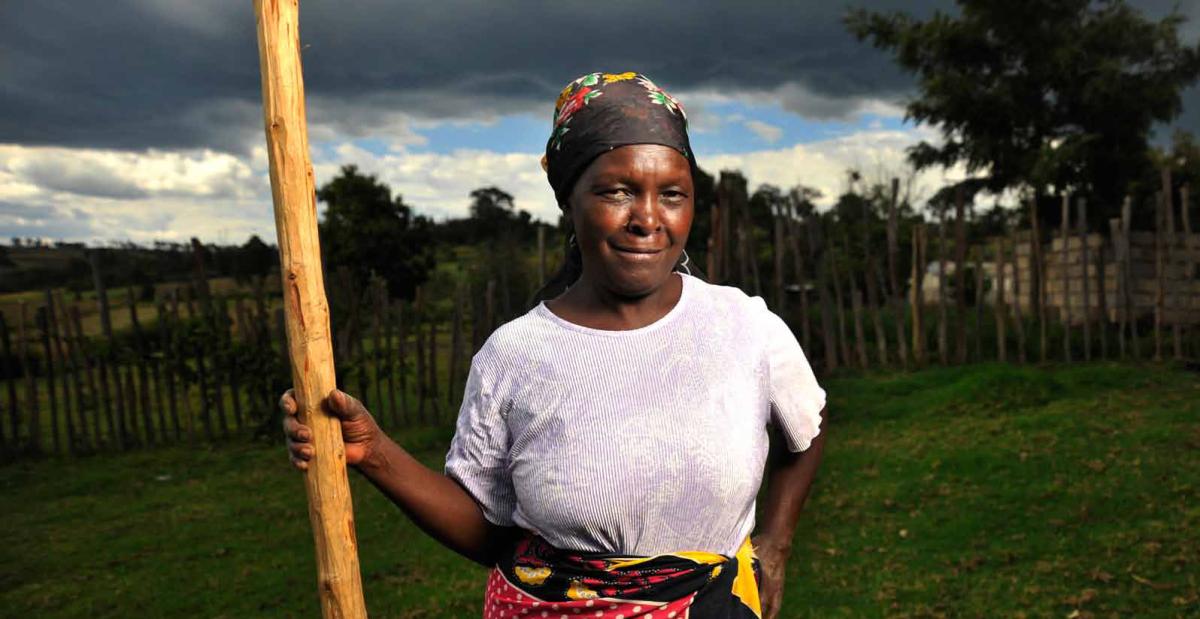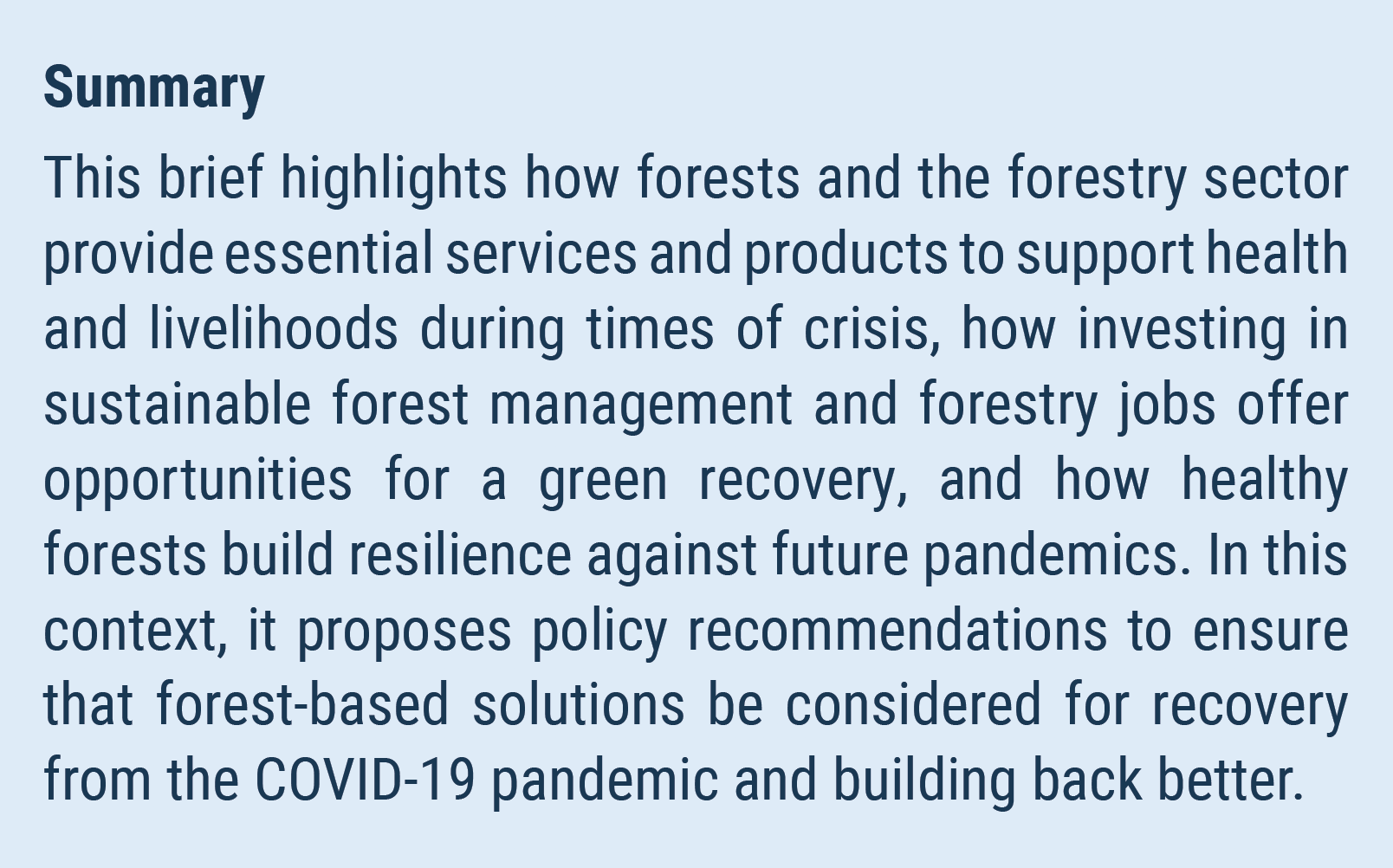
 The COVID-19 pandemic has brought to the forefront some of the most pressing global challenges that humanity has faced in recent history. Health systems have been stretched thin and lockdown measures have taken a heavy social and economic toll, the devastating impacts of which are being felt by all – from urban residents of densely populated megacities to indigenous peoples living deep in the heart of forests. As countries respond to this global crisis, the focus is on strengthening health systems, cushioning the knockon effects on livelihoods and economies and building back better (UN, 2020a). At the same time, it is becoming increasingly clear that the path ahead represents a oncein- a-lifetime opportunity to shift the global development paradigm towards greater sustainability and a greener, more inclusive economy. Forests and trees provide income, livelihoods and well-being for rural populations, particularly indigenous peoples, small farm holders, and other forest-dependent communities that live near forests. Forests mitigate climate change by removing about a third of the global greenhouse gas emissions each year (IPCC, 2013). Furthermore, the forestry sector produces essential products and services which underpin public health the world over. If the crisis continues unabated, this reliance on forest goods and services is also likely to see a sharp increase. Which raises the question of how we ensure that forests continue to play a central role in people’s wellbeing, without raising the risk of deforestation and forest degradation. Sustainable forest management can play a vital role in lifting millions out of poverty, and in building resilient economies and societies that can withstand pandemics, climate change and other global challenges. For this to happen, governments, the United Nations system and other key development partners will need to take swift decisive action to build sustainable forest-based solutions into their COVID-19 responses. The global vision and plan of action for forests and people are already enshrined in the UN Strategic Plan for Forests 2030 – what is needed is the political will, international solidarity and accelerated action at all levels to deliver on the promise of a greener future.
The COVID-19 pandemic has brought to the forefront some of the most pressing global challenges that humanity has faced in recent history. Health systems have been stretched thin and lockdown measures have taken a heavy social and economic toll, the devastating impacts of which are being felt by all – from urban residents of densely populated megacities to indigenous peoples living deep in the heart of forests. As countries respond to this global crisis, the focus is on strengthening health systems, cushioning the knockon effects on livelihoods and economies and building back better (UN, 2020a). At the same time, it is becoming increasingly clear that the path ahead represents a oncein- a-lifetime opportunity to shift the global development paradigm towards greater sustainability and a greener, more inclusive economy. Forests and trees provide income, livelihoods and well-being for rural populations, particularly indigenous peoples, small farm holders, and other forest-dependent communities that live near forests. Forests mitigate climate change by removing about a third of the global greenhouse gas emissions each year (IPCC, 2013). Furthermore, the forestry sector produces essential products and services which underpin public health the world over. If the crisis continues unabated, this reliance on forest goods and services is also likely to see a sharp increase. Which raises the question of how we ensure that forests continue to play a central role in people’s wellbeing, without raising the risk of deforestation and forest degradation. Sustainable forest management can play a vital role in lifting millions out of poverty, and in building resilient economies and societies that can withstand pandemics, climate change and other global challenges. For this to happen, governments, the United Nations system and other key development partners will need to take swift decisive action to build sustainable forest-based solutions into their COVID-19 responses. The global vision and plan of action for forests and people are already enshrined in the UN Strategic Plan for Forests 2030 – what is needed is the political will, international solidarity and accelerated action at all levels to deliver on the promise of a greener future.
Forests support human wellbeing, especially in times of crisis
Forests and trees provide safety nets for the vulnerable
For centuries, forests have served as safety nets for the rural poor, although economic growth since 2000 may have reduced poor communities’ reliance on forests (Wunder et al. 2014). Amongst the extreme poor in rural areas, 40 per cent live in forest and savannah areas (FAO, 2018). It is estimated that forest products provide food, income, and nutritional diversity for about 20 per cent of the global population, especially women, children, landless farmers and other vulnerable segments of society (FAO, 2018). The global turmoil that the pandemic has created will almost certainly increase global poverty. Recent analysis indicates that COVID-19 related loss of jobs and income will likely push 34.3 million more people into extreme poverty in 2020. In the worst-case scenario, 160 million more people could face extreme poverty by 2030 (UN 2020b). This crisis will disproportionately affect today’s most marginalized groups, including the rural poor and in particular indigenous peoples living in forests. Many indigenous peoples have a deep cultural and spiritual relationship with ancestral forests and are the keepers of traditional knowledge on forest biodiversity, much of which is at risk of being lost (FAO/UNEP, 2020). Indigenous peoples tend to be in the most “vulnerable” health category, due to higher rates of communicable and non-communicable diseases, high mortality rates and lower life expectancies (UN DESA, 2020). Many indigenous peoples are coping with the pandemic by retreating deeper into forests for food, fuel and shelter, and to protect themselves from the risk of COVID-19 infection (Anderson, 2020). Around 2.4 billion people – one-third of the world’s population – still rely on wood fuel to meet their basic energy needs, such as cooking food, boiling water and heating their homes. Wood fuel, which includes both fuelwood and charcoal, remains one of the most affordable and accessible energy sources for people affected by natural disasters and humanitarian crises. It is estimated that of the 850 million people who engage in fuelwood collection or charcoal production, the vast majority (83 per cent) are women (FAO, 2018). Reliance on forest biomass energy will likely grow during the COVID-19 crisis, as supply chains of other energy sources get disrupted, and income-generating opportunities decrease. The sharp increase in economic vulnerability will in turn increase pressure on forests to play their safety-net role once again, as more people amongst the rural poor turn to forest products for their fundamental subsistence needs. The number of rural poor will likely swell even more as reverse migration from cities to rural areas sets in and millions grapple with the sudden loss of income and food insecurity due to COVID-19.
Forests provide essential health products
Many essential supplies that public health systems rely on are derived from forest products, as witnessed by the fact that forest industries have been deemed as essential industries since the COVID-19 lockdown. Disposable hygiene and sanitary supplies, including toilet paper, paper towels, tissues and ethanol for sanitizers, are all derived from forests (FAO, 2020). Manufacture of personal protective equipment (PPE), such as masks and protective clothing for medical workers, utilizes wood pulp and soluble cellulose fiber. Among urban populations, increased reliance on e-commerce shipments and home delivery services during COVID-19 lockdowns has also placed the spotlight on the need for paper and cardboardbased packaging products in enabling delivery of food products and other household items to people’s homes. One of the key preventive measures to safeguard public health is access to clean water. Currently, an estimated 2.2 billion people lack access to clean water, making them unable to utilize one of the most basic and effective prevention measures against COVID-19 – frequent and thorough handwashing (UN, 2020a). Forests are integral to the global water cycle, with threequarters of the planet’s accessible freshwater coming from forested watersheds. Forests affect rainfall patterns, filter water, reduce soil erosion and provide most of the drinking water for over one-third of the world’s largest cities (FAO, 2018). In addition to these consumable products, green spaces, city parks and forests are vital for the health and wellness of communities. As indoor public recreation facilities have closed to slow the spread of COVID-19, the use of outdoor recreation facilities has been a social distancing appropriate alternative – such as hiking, biking, camping, fishing, birdwatching and nature walks. Being in forests or parks with trees offers a myriad of benefits for human physical, mental and spiritual health (FAO/UNEP 2020). Spending time in forests, parks or simply looking at trees, helps to boost immune systems, reduces stress, lowers blood pressure, improves mood and relaxation. In Japan, the practice of “forest bathing” or “Shinrin-yoku” is part of the country’s health system and is considered a form of preventive medical therapy.
Restoring forests restores jobs
With nearly the entire world economy under some form of lockdown and unemployment rates skyrocketing, governments are increasingly under pressure to develop and deliver economic recovery packages. This presents a timely opportunity for policy and investment decisions to steer the future towards greener, more sustainable and inclusive policies that will act as a foundation for resilient people and societies. A 2020 study by leading economists found green fiscal recovery packages to be the most beneficial for COVID-19 recovery and identified five policy areas in this regard, namely, clean physical infrastructure, building efficiency retrofits, investment in education and training, natural capital investment, and clean research and development (Hepburn et al, 2020). Natural capital spending, in sectors like forestry, tends to be “shovel-ready” and fast-acting because worker training requirements are low, require minimal planning and procurement, and meet social distancing guidelines. The forestry sector has been well recognized for its employment-generation potential, due to its labor-intensive nature as well as relatively low capital investment requirements (Nair, 2009). Areas with potential for new forestry jobs include afforestation, reforestation, improved management of natural forests, conservation, watershed protection, agroforestry, urban forestry, protection of forests from fire and building roads, trails and recreation sites. India and Pakistan are addressing COVID-related reverse migration by creating new jobs for afforestation, reforestation and agroforestry. India recently announced funding of INR 60 billion (about USD 790 million), to be approved under its Compensatory Afforestation Fund Management and Planning Authority (CAMPA) to generate employment through afforestation and forest restoration activities in urban, semi-urban and rural areas (Government of India, Press Information Bureau, 2020). At the state level, Jharkhand (which aptly translates as the “Land of Forests”) in eastern India has created a new afforestation-based income-generation programme to provide jobs for migrant workers (Mukesh, 2020). As part of the programme, 500,000 families will each be provided with 100 fruit-bearing trees, saplings and plants over the next five years. In Pakistan, unemployed day laborers have been given new jobs to plant saplings as part of the country’s 10 Billion Tree Tsunami programme (Khan, 2020). It is expected that more than 63,600 jobs will be created, many of which will be in rural areas, with a focus on hiring women. Likewise, Iceland has announced USD 3.7 million in funding for plans to address climate change as part of the country’s second COVID-19 economic stimulus package, which includes funds for land reclamation projects, land quality recovery and creating new birch forests (Musto, 2020).
Healthy forests reduce risk of future pandemics
It is estimated that 60 per cent of all infectious diseases in humans and 75 per cent of all emerging infectious diseases are zoonotic, i.e., originating from the transfer of pathogens from animals to humans (UNEP, 2016). Zoonoses typically emerge when natural landscapes, including forests, are cleared for other use such as agricultural expansion and human settlement. This habitat loss results in a reduction or loss of traditional buffer zones that separate humans from animals or from the pathogens that they harbour. A 2020 study found that deforestation could lead to a rise in the occurrence of diseases like COVID-19 in the future (Bloomfield, 2020). The study’s findings suggest that when forests are cleared for agricultural use, the chances of transmission of zoonotic diseases increase. Ecosystem degradation, large-scale deforestation, illegal trade in wildlife and climate change are all drivers of emerging zoonotic diseases. Climate change influences environmental conditions which in turn affect the spread of pathogens, vectors and hosts. As the global climate continues to change, it is expected that outbreaks of epidemic diseases are likely to become more frequent. Research indicates that land conservation, reduction of forest loss and fragmentation, creation of buffer zones through forest restoration could reduce human-wild animal interactions and thus reduce the risk of future disease outbreaks (Bloomfield, 2020).
Conclusions and recommendations
As the global community battles the COVID-19 pandemic, it is increasingly clear that building back better will require a quantum shift in the approach to disaster preparedness. While the current crisis was unimaginable a few months ago, it is unlikely to be the last global crisis the world will face. UN Secretary-General António Guterres’ has referred to COVID-19 as an “unprecedented wake-up call”. If the aspiration for a green COVID-19 recovery is to materialize, sustainable and healthy forest ecosystems and resilient forest-dependent communities must be a major pillar. Forests not only help alleviate poverty among rural communities, but they also underpin strategically crucial sectors such as public health, employment and disaster risk reduction. At the same time, they continue to be under threat from illegal logging, wildfires, pollution, storms, pests, and the impacts of climate change. Now more than ever, as marginalized and vulnerable communities turn to forests during the COVID-19 crisis, the international community needs to rise to the challenge and reaffirm its commitment to the sustainable management of all forests and trees outside of forests. The path has already been charted clearly in the UN Strategic Plan for Forests 2030 with its Global Forest Goals and in the 2030 Agenda with its Sustainable Development Goals. Building upon the above policy frameworks, the following recommendations in the context of COVID-19 recovery could be considered at both national and international levels:
- Promote sustainable forest management at all levels by accelerating the implementation of the UN Strategic Plan for Forests 2030 and the achievement of the Global Forest Goals and targets.
- Establish post COVID-19 recovery programmes to improve the livelihoods and build resilience of forestdependent people, indigenous peoples and local communities. Promote efforts to halt deforestation, prevent forest degradation and increase forest area through investment in forestry-related jobs as part of COVID-19 economic recovery stimulus packages, including afforestation, reforestation, conservation, watershed protection, agroforestry and urban forestry jobs.
- Enhance forest law enforcement and governance systems, including through strengthening national forest authorities, and strengthening measures to combat illegal logging and illegal trade in wildlife.
- Promote the production of timely and appropri a tely disaggregated official statistics on the status of forests, including by undertaking research and analysis on the impact of the COVID-19 pandemic on progress towards sustainable forest management.
 Welcome to the United Nations
Welcome to the United Nations

